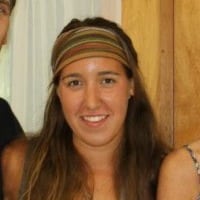One of Stan Jensen’s mentors, Dick Collins, once said, “One of the key principles in this sport is volunteering. You cannot just show up, pay the entry fee, and run. You have to give back.”
These words are Stan’s daily inspiration. Balancing between hours spent cheering runners on the trails, maintaining the online resource Run100s.com, rescuing marine mammals, and more, Stan gives back to the worlds that have given him so much.
Stan, 62, was born in Southern California and currently lives in Pacifica, California. He attended school for geography at the University of California, Davis before becoming an employee at Silicon Graphics working with computers.
He began running in high school, and then kept going through college for recreational purposes.
Stan never planned his runner-turned-ultrarunner and computer-focused-employee-turned-full-time-volunteer lifestyle.
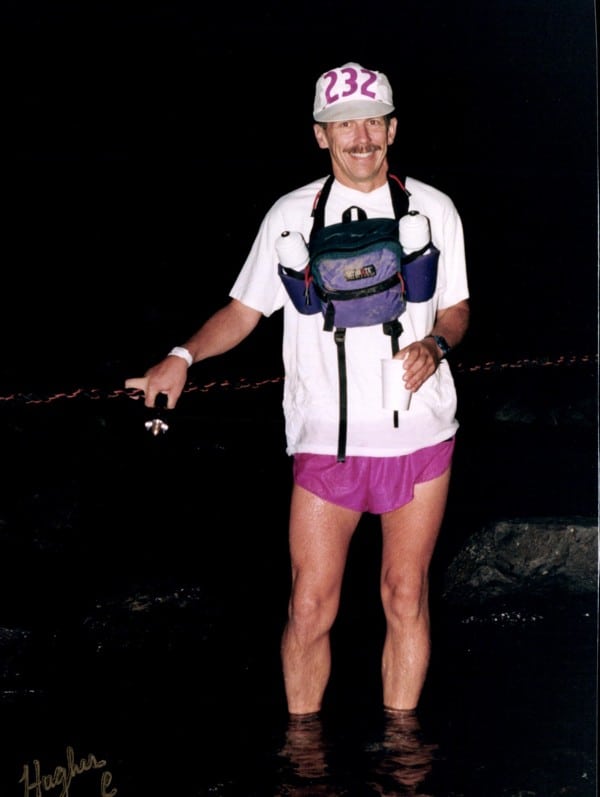
Stan Jensen crossing the American River during his first Western States 100. All photos courtesy of Stan Jensen.
Stan said, “People always say, ‘What do you want to be when you grow up?’ I had no idea. Had no idea it would be a geography degree. Had no idea it would lead to a computer job. Had no idea 10k’s would turn into 100 milers.” It was also unknown to him that he would one day spend his time hands deep in water, rescuing endangered marine mammals.
Technically, Stan is retired. Yet, he travels and works as if he has several full-time jobs.
Between volunteering at The Marine Mammal Center in Sausalito, California, offering his time and experience at 100-mile races throughout the West Coast, donating blood, and managing one of the original ultrarunning websites, his volunteering makes me want to ask, “Okay, when do you sleep?”
Even before volunteering at races and the marine center, the act of giving was already in his blood, literally. In 1984, Stan began donating whole blood samples to the Stanford Blood Center at Stanford University. He also began donating platelets in 1985. He has donated over 400 times to the center. He says because of his high platelet count, he is able to donate three units of platelets at each visit and replenish them in enough time to return in two weeks.
“My type is A-, but my blood is “CMV-,” which means I don’t carry Cytomegalovirus, which would be harmful in premature babies,” he said. That means Stan’s donations can be used for infant operations performed at Lucile Packard Children’s Hospital in Stanford. His most recent donation took place on August 31.
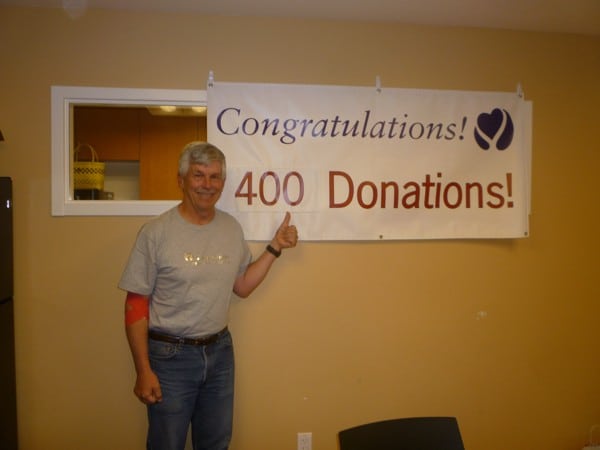
Reaching a milestone of 400 blood donations.
After retiring from his job in California, Stan came across a flyer full of information on the marine center. “The flyer said they needed volunteers, no skills needed,” he said. “The first day I lifted a sea turtle. The very first day, I learned there were turtles in the sea and I physically got to touch one. I was hooked.”
That was 15 years ago, and since he has spent two to three days a week at the center, sometimes every day when the shelter gets busy. Because Stan is not married, he says he can be more available to the workers, and is able to fly to places where animals need assistance.
During the day, he prepares food for the animals’ breakfasts and assists with any medical issues and relocating animals when needed.
“Most people like the otters,” he said, agreeing that the otter is among his favorite animals. “I got to bottle feed a nine-week old otter. I gave him a bath, dried him off, and put him to sleep, too!”
The first day at the center, Stan’s eyes opened to a new world, one where he was needed for the safety of others’ lives, whether it was for supplying food or bandaging injuries.
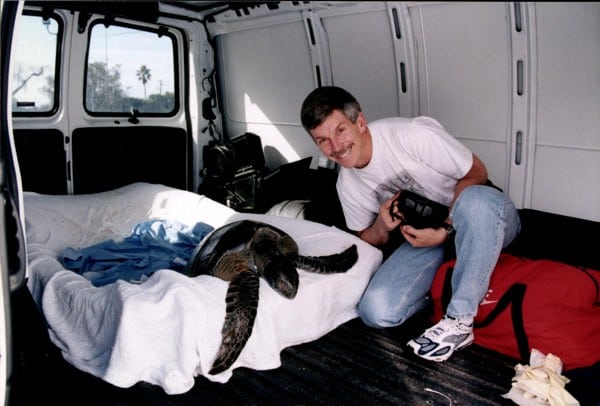
Transporting a sea turtle before it would be released back into the ocean.
His entrance to the ultra world hooked him as well, yet in a different way. Stan says this world saved him, supplying friendships, goals, and a lifelong passion.
His first ultra was a result of falling in love with trails. He ran the American River 50 Mile Endurance Run in 1993. The softer ground, beautiful scenery of the forest and the ocean, and wild turkeys and deer, Stan said he was instantly connected to the sport.
The peacefulness of the trails did not completely overpower Stan’s competitive side. He said the American River 50 Mile was run to spite the guy who dropped out last minute and offered Stan his race bib. “I wanted to better his time,” he said. “I did. 9:50. It was hard but that was what I was expecting.”
The trails provided Stan with a sense of family and friendship not usually seen on the roads. People are friendlier and more talkative on the trails, he commented. They ask what shoes you’re wearing and make sure you’re okay when you stumble and fall.
“My first 100k, the Miwok [100k Trail Race], I sprained my ankle and was walking in a six-mile stretch between the aid stations,” he said. His pace, up in front with the leaders, might have been a little faster than he planned to run, he noted. “The lead woman caught up to me and asked if I’d like her to walk with me to the aid station. It’s that type of sport, where somebody will give up their race to help you. It is just great.”
His love of the sport pushed him through thousands of miles of trails all over the country. The first time he set foot on the Western States (WS100) course, it was as a spectator watching a few training buddies complete the before-unknown race. Then, it took him two years to get in.
“I was hoping I wouldn’t get picked because I knew I wasn’t ready,” he admitted.
Not wanting to be the 100-mile virgin on the WS100 course, he and his friends signed up for the Angeles Crest 100 Endurance Run (AC100). A big advantage going into the WS100, he thought it would give him some experience in what it takes to run 100 miles. Yet, Stan said it was still hot and hard.
But when States rolled around, he was ready and finished in 28 hours, 46 minutes, and 4 seconds. That was at age 43. He has three overall finishes: 1996, 1998, and 1999. His fastest running of the race was in 1999, where he finished in just under 27 hours.
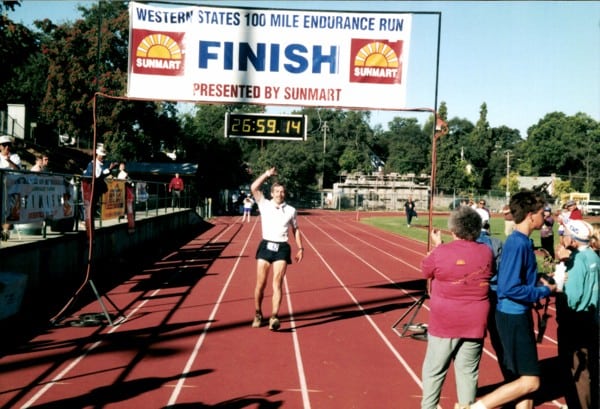
Stan finishing his third and final Western States with a PR.
A lover of the race and its history, Stan said even if he could run it again, he would not return to the WS100 as a competitor. “It is not fair to run again when there are all these people not getting in,” he said. Say something like that in any other situation and you’re probably receiving a few odd looks. But, say something that selfless in the ultra community and people don’t think twice. That is why a life spent giving back to a community of runners, race directors, and aid-station helpers is now Stan’s not-so-regular ‘regular’ life.
Today, Stan is unable to run due to an old knee injury. In 2002, he was working with a large sea lion at The Marine Mammal Center. The slippery, blubbery body escaped and all the workers went down in a heap, pushing someone’s body into Stan’s knee.
“Something snapped and the doctor said something was torn,” he said. “But, it was just an accident.” The non-running injury destroyed his running lifestyle, and Stan was forced to weigh his options. Have expensive, painful surgery or enjoy the sport in a new way? “Volunteering,” he said. “It doesn’t bother me to stand there and watch others race.”
It is a chance to live vicariously through every runner who comes into the finish line. Whether it is watching a family come through with their first-time runner or watching Rob Krar jog in flip flops alongside Gunhild Swanson like this year at WS100, Stan said helping out is just as filled with special rewards. “You get to see the emotional side of the sport,” he said. “You get to see people kiss their medal and see the crews who are almost as happy as their runner.”
For just about every race he has personally run, Stan has returned to volunteer, even for summer-long multi-race efforts like The Grand Slam of Ultrarunning and The Last Great Race. Stan was asked to pace his friend Tom O’Connell during his attempt at the Grand Slam in 1995. “He asked if I would pace him at Western States,” he said. “I said, ‘Are you kidding? I can’t keep up with you.'” “Don’t worry,” O’Connell had responded. “You’ll keep up, and if not then I’ll leave you, deal?”
Stan was not left. Instead, he was struck with the longing of completing the series himself. In 1997 he attempted and was forced to drop out of the Slam during the Leadville Trail 100 Run with a leg problem. He vowed to himself that he would return, however.

The six finisher buckles from Stan’s completion of The Last Great Race series.
In 1999 Stan came across The Last Great Race, a series of the oldest 100-mile races in the country. The series included an entire summer of 100s: Old Dominion 100 Mile Cross Country Run, the WS100, Vermont 100 Endurance Run, Leadville, Wasatch Front 100 Mile Endurance Run, and the AC100.
He took the adventure seriously, attending a Leadville training camp and preparing by running the Umstead 100 Mile in April to get in the 100-mile mindset. And, he was mentally focused on conquering Old Dominion, an old DNF that was asking for another go.
“Going into that summer I was in the best shape both mentally and physically,” he said. The hardest race of the series was once again Leadville, he said. The spacing of aid stations, altitude, weather… he counted off. “There are just so many things that could go wrong.” That 1999 summer was like spending time with one big family among those who were involved in the series, both runners and crews, he described.
Out of the 130 or so ultras Stan has finished, 14 have been 100 milers. “It looks like I have done a lot, but that is just because I did the six in one summer,” he claimed. “But, I like them because they are a challenge.”
Stan looks at the ultra distances like they are steps on a ladder, each one adds a bit more effort. “The 50k is not much more than a marathon, and the 50 milers seemed like a big difference,” he said. “The first 100k, it was, wow, you’re out there for 14 to 17 hours. You run at night. You’re tired. But 100 milers. They are even one more step.”
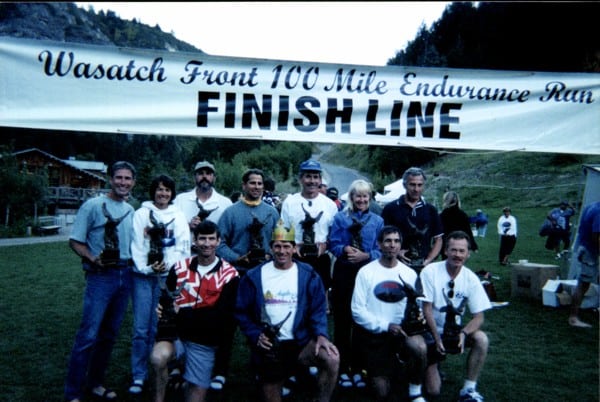
The 11 Grand Slammers of 1999.
He completed the race series with just one bad race, Wasatch, which he claims is ironic since the Utah-based point-to-point is his favorite race he’s ever done. “I almost lost it,” he said. “My electrolytes were out of balance and I was dizzy.” At the aid station during the race he was forced to take a nap and drink soup for three hours.
“My sister was there, and could tell by the tone of my voice after that I was recovered,” he remembered. “I woke up and said, ‘I think I need to stay longer.’ ‘No, you’re good to go,’ she told me.”
Stan completed The Last Great Race series that year with six other racers. Since it was founded in 1989, there have been 39 finishers. It’s since been renamed the Original Six Hundo Challenge series.
After completing the six 100 milers in 1999, Stan was back again a few years later, volunteering rather than running for those competing in the Grand Slam and The Last Race. At races, he works with UltraLive.net, and says his favorite part is being able to see who is running each race and who finishes. For most races he tries to work both the start and finish. “The best part about volunteering is being able to put a face with a name,” he explained. “At WS100 for example, I help out with bibs and timing chips and see the gun go off in the morning. Then I drive to Auburn and help out with the finish-line stuff.”
In addition to volunteer positions, he also ends up at races as co-race director. He’s been roped into race directing Hawaii’s H.U.R.T 100 Trail Race for the last few years.
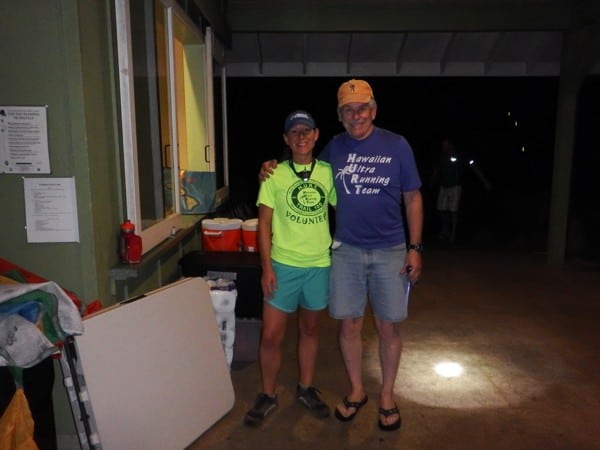
Stan with Shell Barbieri while co-race directing the H.U.R.T 100.
“As an ultrarunner you never appreciate the backside of the race,” he said. “It is an awful amount of work.”
H.U.R.T race directors John and P.J. Salmonson said Stan first came out during the race’s fifth running, and has now helped out for the last nine or 10 years. “Stan is unbelievable and indispensable,” John said. “Most people don’t realize that Stan’s running volunteering actually takes second seat to his Marine Mammal Center volunteering. I’m guessing he averages 40 to 50 hours a week volunteering and he’s so good, he’s in high demand. We’re very lucky to get some of that!”
Runner, race director, volunteer: a full circle, preparing him with years of experience and knowledge of the sport.
These positions have led to meeting new people and staying up to date on the latest ultra news. Combining everything together, Stan successfully keeps up with his website, Run100s.com. While working at his computer job back in 1996, Stan’s boss asked him to create a website as a way of jumping into the new internet boom. He told Stan to create something that meant something to him and would be easy to write about. In the boom of his running, Run100s.com was born and now more than 20 years later, it is still one of the most frequently visited ultrarunning websites.
Today, Stan works on the site almost every day, either updating new race stats and information, uploading results, posting new races and adding to the helpful resources tabs, which include blog posts and articles. “There are so many websites, and practically every event has its own page,” he said. Stan has race directors emailing him about updates and has new race directors asking about promoting their events.
Personally, he checks Facebook for race notices and constantly stays absorbed in race coverage during big races, like the coverage on the Ultra-Trail du Mont-Blanc a few weeks ago.
With a resume like Stan’s, I figured he would be the number-one guy to ask for the latest news in the ultra world and a good guy to talk to about training for a 100-mile running race. But when I asked him if he received help requests from fellow runners, his reply was “thankfully, no!”
“I haven’t been active in the ultra world in five or 10 years,” he said, though I personally would count his participation in the ultra scene as an active one. “I would say I am more of librarian than someone who gives advice.”
Stan Jensen: the walking encyclopedia of ultramarathoning. It has a nice ring to it.
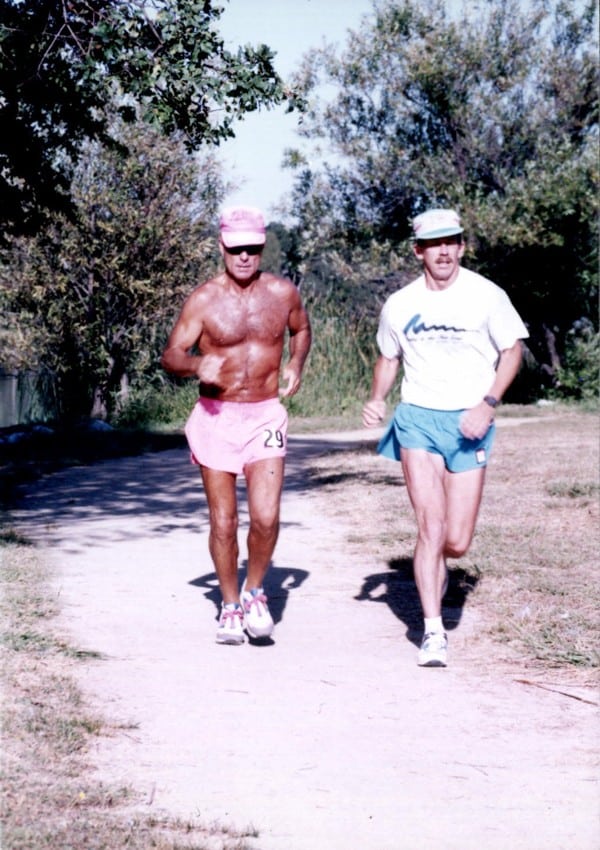
Running with John Clark during the Cameron Park 50 Mile in 1996.
He described his new lifestyle as being able to help people find how to make their own choice.
“What’s a good 100 miler?”
“Want one with elevation? Close to home? Loop format? Go to the main page and scroll through the 140 options to choose from.”
“Is this a good type of running shoe?”
“Go to a running store and talk to those guys, or go to a race and talk to someone with those shoes.”
“I am good at telling people where to go,” he claimed.
For Stan, there is more to the book smarts of the ultra world. From the years of running and volunteering, he has been up close and personal with the hardships, pain, and victory of what the races posted on his website produce in runners.
We all know how hard it is to be on the sidelines, cheering others on but wishing it was us dripping with sweat, swallowing that 25th gel. But for Stan, he is happy feeding hungry runners at mile 70 and watching the last runners cross the finish line even after the time limit is up.
Because even if he is not physically running, he is volunteering each beat of his heart with each pounding of the shoes on the trail.
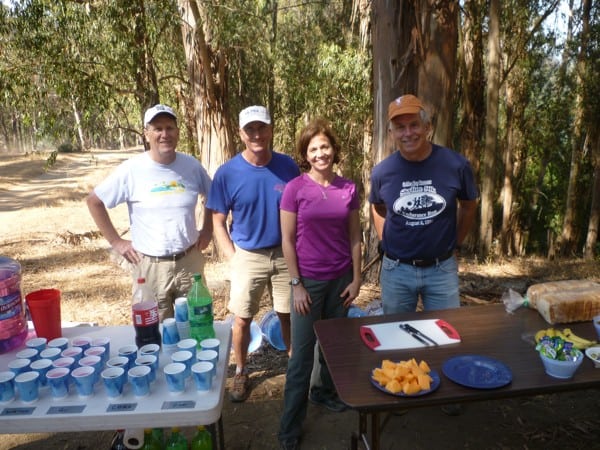
Stan and his crew at the Honker Bay Aid Station during the 2012 Skyline 50k Endurance Run.
Call for Comments (from Meghan)
Hang around the American ultra scene long enough and you’re sure to meet Stan Jensen. Comment here to share your stories about running and volunteering with him!
